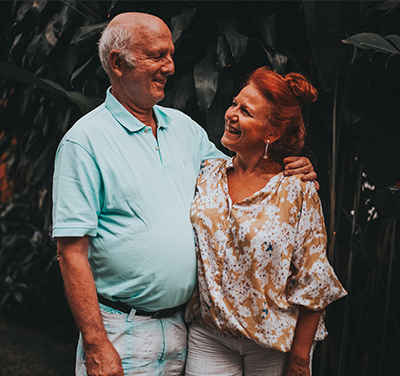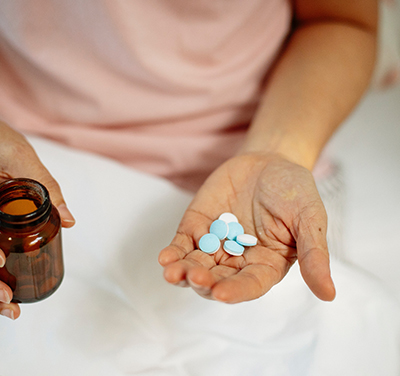Anxiety Disorders
Introduction:
- Feeling anxious or nervous is a common emotion for people of all ages and a normal reaction to stress
- Feeling anxious can help us handle problems and strange situations, and even avoid danger
- It is normal to feel anxious about illnesses, new social interactions, and frightening events
- But when one feels anxious often and the anxiety is overwhelming and affects daily tasks, social life, and relationships, it may be an illness
- Anxiety is a common illness among older adults, affecting as many as 10-20 percent of the older population, though it is often undiagnosed
- Phobia—when an individual is fearful of certain things, places or events—is the most typical type of anxiety
- Among adults, anxiety is the most common mental health problem for women, and the second most common for men, after substance abuse
- Older adults with anxiety disorders often go untreated for a number of reasons
- Older adults often do not recognize or acknowledge their symptoms
- When they do, they may be reluctant to discuss their feelings with their physicians
- Some older adults may not seek treatment because they have suffered symptoms of anxiety for most of their lives and believe the feelings are normal
- Both patients and physicians may miss a diagnosis of anxiety because of other medical conditions and prescription drug use, or particular situations that the patient is coping with. For example, the anxiety suffered by a recently widowed patient may be more than normal grieving. Complicated or chronic grief is often accompanied by persistent anxiety and grieving spouses may avoid reminders of the deceased
- Untreated anxiety can lead to cognitive impairment, disability, poor physical health, and a poor quality of life
- Fortunately, anxiety is treatable with prescription drugs and therapy
WHAT IS ANXIETY?
Feelings of fear, worry, apprehension, or dread that are excessive or disproportional to the problems or situations that are feared. There are several types of anxiety disorders.
Specific Phobias:
A specific phobia is an intense, irrational fear of a place, thing or event that actually poses little or no threat.
Some common specific phobias:
- Heights
- Escalators
- Tunnels
- Highway driving
- Closed-in spaces
- Flying
- Spiders and Snakes
Agoraphobia : Fear of :
- Public places
- Leaving one’s home
- Being alone
Phobias more common to older adults include:
- Fear of death
- Disaster to family
- Dental procedures.
Facing, or thinking about, above situations or things can bring on severe anxiety or a panic attack
- Chest pain
- Heart palpitations
- Shortness of breath
- Dizziness
- Nausea
Social phobia (also called social anxiety disorder):
- Social phobia is when an individual feels overwhelmingly anxious and self-conscious in everyday social situations
- An older adult might feel intense, persistent, and chronic fear of being judged by others and of doing things that will cause embarrassment
- Some older persons suffer a social phobia because they are embarrassed about being unable to remember names or are ashamed of their appearance due to illness
- A social anxiety disorder makes it hard to make and keep friends
- Some with social phobia can be around others, but are anxious beforehand, very uncomfortable throughout the encounter, and, afterwards, worry how they were judged
Physical symptoms can include:
- Blushing
- Heavy sweating
- Trembling
- Nausea
- Difficulty talking.
Generalized Anxiety Disorder (GAD):
- Those with GAD suffer constant worries, and there may be nothing or little to cause these worries
- Those with GAD are overly concerned about health issues, money, family problems, or possible disaster
- Those with GAD usually understand that they worry more than necessary
- Older adults with GAD have difficulty relaxing, sleeping and concentrating, and startle easily
Symptoms include:
- Fatigue
- Trembling
- Headaches
- Twitching
- Muscle tension
- Muscle ache
- Irritability
- Sweating
- Difficulty swallowing
- Nausea
- Lightheadedness
- Having to go to the bathroom frequently
- Short of breath
- Tightness in the chest
- Hot flashes
Post-Traumatic Stress Disorder (PTSD):
-
- History of a traumatic event that involved physical harm or the threat of physical harm to the individual, a loved one, or even strangers
- PTSD can result from traumatic incidents, such as
1. Mugging
2. Rape
3. Abuse
4. Car accidents,
5. Natural disasters such as floods or earthquakes,
6. Experiences of war.
- Symptoms may emerge months or years after the event
- Some older adults may relive a trauma 30 years or more after an event due to feeling helpless because of a new disability (for example, being confined to a wheelchair)
- Specific triggers that revive old memories (for example, news coverage of current wars).
Symptoms
A. Re-experiencing the traumatic events as:
- Flashbacks (As if the traumatic event is happening again)
- Nightmares
- Intrusive thoughts and Dreams of the trauma
- Psychological distress
- Physiological Reactivity( Physical symptoms such as Racing heart. Tightness in the chest, flushing, swallowing difficulty etc.
B. Avoidance:
- Emotional numbness
- Avoidance of places, people, and activities that are reminders of the trauma
- Feeling of detachment from others
- Affective instability
- Feeling of love lost to others
- Feeling of foreshortened future
C. Hyper-arousal:
- Sleep disturbances (Falling asleep and maintaining sleep)
- Poor concentration
- Irritability, anger (Fly of the handle)
- Feeling jumpy
- Feeling of foreshortened future
Obsessive Compulsive Disorder (OCD)
While OCD is not common among older adults, some older people do suffer from persistent, upsetting thoughts that they control by performing certain rituals such as:
1. Repeatedly checking things
2. Touching things in a particular order
3. Counting things
4. Some common fears include possible violence and harm to loved ones
5. Some with OCD are preoccupied with order and symmetry
6. Others accumulate or hoard unneeded items.
Panic Disorder
Those with panic disorder have sudden attacks of
1. Terror
2. Pounding heart
3. Chest pain
4. Sweating
5. Weakness
6. Fainting
7. Dizziness, or nausea
Panic attacks can occur at any time, even during sleep. An attack usually peaks within 10 minutes, but some symptoms may last much longer. Panic disorder is not common among older adults; however, an older adult with the disorder may refuse to be left alone. An older person experiencing a panic attack may think he or she is having a heart attack or stroke.
WHY SHOULD AN OLDER ADULT BE CONCERNED ABOUT ANXIETY?
For older adults, depression often goes along with anxiety, and both can be debilitating, reducing overall health and quality of life. It is important to know the signs of both anxiety and depression and to talk with a physician about any concerns. Anxiety is also strongly linked to memory. Anxiety can interfere with memory, and significant anxiety can contribute to amnesia or flashbacks of a traumatic event.
WHAT LEADS TO ANXIETY DISORDER?
A number of things can contribute to an anxiety disorder:
- Extreme stress or trauma
- Bereavement and complicated or chronic grief
- Alcohol, caffeine, drugs (prescription, over-the-counter, and illegal)
- A family history of anxiety disorders
- Other medical or mental illnesses or
- Neurodegenerative disorders (like Alzheimer’s or other dementias).
The stresses and changes that sometimes go along with aging and could cause anxiety such as:
1. Poor health
2. Memory problems
3. Losses
4. Common fears about aging
5. Afraid of falling,
6. Unable to afford living expenses and medication
7. Victimized,
8. Dependent on others
9. Loneliness
10. Thoughts of death.
Older adults and their families should be aware that health changes can also bring on anxiety. Anxiety disorders commonly occur along with other physical or mental illnesses, including alcohol or substance abuse, which may hide the symptoms or make them worse.
It’s also important to note that many older adults living with anxiety suffered an anxiety disorder (possibly undiagnosed and untreated) when they were younger.
A stressful event, such as the death of a loved one, can cause a mild, brief anxiety, but the anxiety that lasts at least six months can get worse if not treated.
WHO CAN HELP?
Older adults who think they may be suffering from anxiety should share their concerns with their primary care physicians. A physician can help determine if the symptoms are due to an anxiety disorder, a medical condition, or both. If the physician diagnoses an anxiety disorder, the next step is to see a mental health care professional. Both patient and provider should work as a team to make a plan to treat the anxiety disorder.
WHAT ARE THE TREATMENT OPTIONS?
1. Medication
2. Therapy
3. Stress reduction
4. Coping skills
5. Family or other social support.
A mental health care provider can determine what type of disorder or combination of disorders the patient has and if any other conditions, such as grief, depression, substance abuse, or dementia, are present.
Those who have been treated before for an anxiety disorder should tell their provider about previous treatment. If they received medication, they should indicate what was used, dosage, side effects, and whether the treatment was helpful. If the patient attended therapy sessions, he or she should describe the type, how many sessions, and whether it was helpful. Sometimes individuals must try several different treatments or combinations of treatments before they find the one that works best for them.
MEDICATION
Medication will not cure anxiety disorders but will keep them under control while the person receives therapy. Medication must be prescribed by physicians, often psychiatrists or geriatric psychiatrists, who can also offer therapy or work as a team with psychologists, social workers, or counselors who provide therapy.
The main medications used for anxiety disorders are antidepressants, anti-anxiety drugs, and beta-blockers, which control some of the physical symptoms.
Antidepressants:
Antidepressants are typically prescribed for most anxiety disorders. They work by altering the brain chemistry. Because symptoms usually start to fade after 4-6 weeks of antidepressants, it is important to take them long enough for them to work. Antidepressants include:
1. Selective serotonin reuptake inhibitors (SSRIs)
2. Serotonin and norepinephrine reuptake inhibitors (SNRIs)
3. Tricyclics,
4. Monoamine oxidase inhibitors (MAOIs).
Please check the depression Module for details of the above medication.
Anti-anxiety drugs: Anti-anxiety drugs, also called anxiolytics, are sometimes prescribed when a quick-acting and/or short-term medication is needed.
1. Buspirone: Anti-anxiety drug that has been shown to be effective for older adults.
2. Benzodiazepines: Effective but should be prescribed carefully to older adults because of the risk of memory impairment, unsteadiness, and falls. When they are used, benzodiazepines are usually prescribed for short periods of time. Some people experience withdrawal symptoms if they stop taking them abruptly instead of tapering off. When taken regularly for a long time, benzodiazepines could be addictive.
3. Beta-blockers: Beta-blockers can help relieve anxiety by preventing the physical symptoms that go along with certain anxiety disorders.
TAKING MEDICATION:
- Learn about the effects (for example, when it should begin to help and in what way) and side effects.
- Tell your doctor about any other drugs (both prescription and over-the-counter), herbal supplements, or alternative therapies you are taking.
- Find out when and how the medication should be stopped. Some cannot be stopped abruptly and must be tapered down under a doctor’s supervision.
- Some medications are only effective if taken regularly.
THERAPY:
Therapy or psychotherapy involves talking with a trained mental health professional, such as a psychiatrist, psychologist, social worker, or counselor, to discover what caused the anxiety disorder and how to deal with its symptoms.
Cognitive-behavioral therapy (CBT) Therapists help people change the thinking patterns that contribute to their fears and the ways they react to anxiety-provoking situations. A therapist can teach new coping and relaxation skills and help resolve problems that cause anxiety. When a patient is ready to face his or her fears, a therapist can teach exposure techniques to desensitize the patient to the situations that trigger anxious feelings. Therapists also teach deep breathing and other relaxation techniques to relieve anxiety. Behavioral therapy is a short-term therapy of 12 or fewer sessions.
WHAT ELSE CAN A PERSON DO TO RELIEVE ANXIETY?
- Acknowledge worries and address any fears that can be handled (for example, if an individual is worried about finances, a visit to a financial planner may be helpful)
- Talk with family, a friend or spiritual leader
- Adopt stress management techniques, meditation, prayer, and deep breathing from the lower abdomen
- Exercise
- Avoid things that can aggravate the symptoms of anxiety disorders:
- 1. Caffeine (coffee, tea, soda, chocolate)
2. Nicotine (smoking)
3. Over-eating
4. Over-the-counter cold medications
5. Certain illegal drugs
6. Certain herbal supplements
7. Alcohol (While alcohol might initially help a person relax, it eventually interferes with sleep and overall wellness, and can even contribute to anxiety, depression, and dementia.) - Limit news of current events. It is important to stay current, but too much negative news can contribute to anxiety.
- Allow time for treatment to work
CONCERNED ABOUT AN OLDER FAMILY MEMBER OR FRIEND?
If you suspect an older adult you know might have a problem with anxiety, notice and ask about any changes in:
- Daily routines and activities. Is the person avoiding situations and activities he or she once enjoyed?
- Worries. Does he or she seem to worry excessively?
- Medication. Is he or she taking a new medication, either prescription or over-the-counter? Or has the dosage changed for one of the medications?
- Is he or she drinking more alcoholic drinks than previously?
- Mood. Is the older adult tearful, lacking emotion, or “just doesn’t feel right.”
When talking with an older adult who has an anxiety problem:
- Be calm and reassuring
- Acknowledge their fears but do not play along with them
- Be supportive without supporting their anxiety
- Encourage them to engage in social activities
- Offer assistance in getting them help from a physician or mental health professional
RESOURCES
American Psychiatric Association
1000 Wilson Boulevard, Suite 1825
Arlington, VA 22209-3901
Phone: (703) 907-7300
Website: www.psych.org
American Psychological Association
750 First Street, NE
Washington, DC 20002-4242
Phone: (800) 374-2721
Website: www.apa.org
Anxiety Disorders Association of America
8730 Georgia Avenue, Suite 600
Silver Spring, MD 20910
Phone: (240) 485-1001
Website: www.adaa.org
National Association of Social Workers
750 First Street, NE, Suite 700
Washington, DC 20002-4241
Phone: (202) 408-8600
Website: www.socialworkers.org
Location
New Hope Clinical Research
3101 Latrobe Dr
Charlotte, NC 28211
Fax : 980-226-5843
Email : contact@newhcr.com
Office Hours
- Monday – 8:00 am – 5:00 pm
- Tuesday – 8:00 am – 5:00 pm
- Wednesday – 8:00 am – 5:00 pm
- Thursday – 8:00 am – 5:00 pm
- Friday – 8:00 am – 5:00 pm
- Saturday – Closed
- Sunday – Closed








